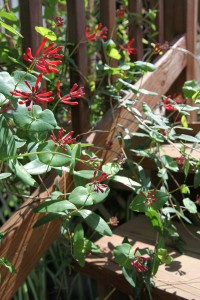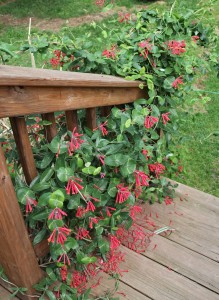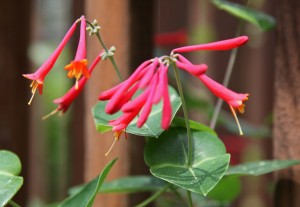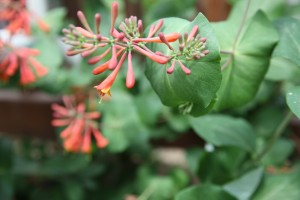Native Honeysuckle (Lonicera Sempervirens) also known as
Trumpet Honeysuckle or Coral Honeysuckle
This is NOT Asian Honeysuckle (that you see taking over many shrubs and yards). This is also NOT Trumpet Creeper (which can be more aggressive then these Honeysuckles).
Type: Perennial Vine (Zones 4/5-9/10).
Light Requirements: Full to Part Sun (some will work in Part Shade)
Moisture/Soil: Average moisture. Once established can take some drought.
Blooms: Late spring to early summer and often continues to bloom on and off again for the rest of the season. It has a LONG bloom season. Different varieties come in coral, reds, oranges, yellows and pink. Then it gets berries in the fall, which are also attractive.
Leaves: Green (looses them in the winter but stay on through the fall).
Size: Length: 10′-20′
Additional Info: I grow several coral and orange colored ones on my deck railing in full sun. I bought mine at a native plant sale at Bartrum Gardens. I have also picked up some at the Scott Arboretum plant exchange. There were a lot there and I tried to convince a couple of people to try them out. Here is a useful link to a story from Dave’s Garden: Native American Honeysuckle.
Pros: They are very low maintenance and can take a good haircut. Bees, butterflies and hummingbirds love them! Does well in my clay soil. Deer resistant.
Cons: Most don’t have a nice fragrance. They can be too aggressive for some “dainty” applications. I would say that the growth is faster in the wet spring and then moderate to little the rest of the season. I’ve heard it can get mildew, but I haven’t had this problem
Origin: I am focusing on the US native cultivars.
Varieties:
‘Blanche Sandman’ – This form has orange-red blooms that are produced even after the initial flush. It is resistant to leaf diseases. I believe this is the one I have.
‘Gold Flame’ (Zones 5-9) (Lonicera x heckrottii) which is a cross between Lonicera L. sempervirens (American) and Lonicera Americana (a European variety) is pink with yellow inside a has the fragrance that I love from the Asian Honeysuckle without being invasive. Reports are that it is more prone to powdery mildew and aphids.
‘Alabama Crimson’ -Â Bright red flowers – a cultivar that is becoming very common.
‘Cedar Lane’ – A deep red-flowering form, this plant produces abundant bloom. It is less prone to leaf diseases.
‘John Clayton’ – Becoming more popular in the trade, this selection bears clear yellow blooms that repeat throughout the season.
‘Sulphurea’ (also known as ‘Flava’) – This form features profuse bright yellow blooms and bright green foliage.
‘Major Wheeler’: Coral (pinky red) on the outside and orange on the inside.
‘Dropmore Scarlet’ - Bright Red.
‘Alba’– White.
Interesting Pairings: I made the mistake of planting invasive honeysuckle with some butterfly bushes in the front yard. It was totally my fault because I ordered it from ebay and they were suppose to send me the native honeysuckle. At the time (7 years ago or so) I wasn’t as experienced with these plants. I think these however would look great planted with butterfly bushes, providing a longer season of color and a nice contrast to the purple flowers of a butterfly bush.
*The Plant of the Week is based on plants that do well in my 7a/6b garden in SE Pennsylvania.







